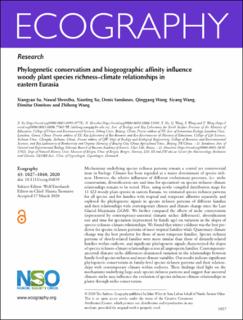| dc.contributor.author | Su, Xiangyan | |
| dc.contributor.author | Shrestha, Nawal | |
| dc.contributor.author | Xu, Xiaoting | |
| dc.contributor.author | Sandanov, Denis | |
| dc.contributor.author | Wang, Qinggang | |
| dc.contributor.author | Wang, Siyang | |
| dc.contributor.author | Dimitrov, Dimitar | |
| dc.contributor.author | Wang, Zhiheng | |
| dc.date.accessioned | 2021-04-23T14:07:46Z | |
| dc.date.available | 2021-04-23T14:07:46Z | |
| dc.date.created | 2020-10-01T22:23:16Z | |
| dc.date.issued | 2020 | |
| dc.Published | Ecography. 2020, 43 (7), 1027-1040. | |
| dc.identifier.issn | 0906-7590 | |
| dc.identifier.uri | https://hdl.handle.net/11250/2739402 | |
| dc.description.abstract | Mechanisms underlying species richness patterns remain a central yet controversial issue in biology. Climate has been regarded as a major determinant of species richness. However, the relative influences of different evolutionary processes, (i.e. niche conservatism, diversification rate and time for speciation) on species richness–climate relationships remain to be tested. Here, using newly compiled distribution maps for 11 422 woody plant species in eastern Eurasia, we estimated species richness patterns for all species and for families with tropical and temperate affinities separately, and explored the phylogenetic signals in species richness patterns of different families and their relationships with contemporary climate and climate change since the Last Glacial Maximum (LGM). We further compared the effects of niche conservatism (represented by contemporary‐ancestral climatic niches differences), diversification rate and time for speciation (represented by family age) on variation in the slopes of species richness–climate relationships. We found that winter coldness was the best predictor for species richness patterns of most tropical families while Quaternary climate change was the best predictor for those of most temperate families. Species richness patterns of closely‐related families were more similar than those of distantly‐related families within eudicots, and significant phylogenetic signals characterized the slopes of species richness–climate relationships across all angiosperm families. Contemporary‐ancestral climatic niche differences dominated variation in the relationships between family‐level species richness and most climate variables. Our results indicate significant phylogenetic conservatism in family‐level species richness patterns and their relationships with contemporary climate within eudicots. These findings shed light on the mechanisms underlying large‐scale species richness patterns and suggest that ancestral climatic niche may influence the evolution of species richness–climate relationships in plants through niche conservatism. | en_US |
| dc.language.iso | eng | en_US |
| dc.publisher | Wiley | en_US |
| dc.rights | Navngivelse 4.0 Internasjonal | * |
| dc.rights.uri | http://creativecommons.org/licenses/by/4.0/deed.no | * |
| dc.title | Phylogenetic conservatism and biogeographic affinity influence woody plant species richness–climate relationships in eastern Eurasia | en_US |
| dc.type | Journal article | en_US |
| dc.type | Peer reviewed | en_US |
| dc.description.version | publishedVersion | en_US |
| dc.rights.holder | Copyright 2020 The Authors | en_US |
| cristin.ispublished | true | |
| cristin.fulltext | original | |
| cristin.qualitycode | 2 | |
| dc.identifier.doi | 10.1111/ecog.04839 | |
| dc.identifier.cristin | 1836424 | |
| dc.source.journal | Ecography | en_US |
| dc.source.40 | 43 | |
| dc.source.14 | 7 | |
| dc.source.pagenumber | 1027-1040 | en_US |
| dc.identifier.citation | Ecography. 2020, 43(7):1027-1040 | en_US |
| dc.source.volume | 43 | en_US |
| dc.source.issue | 7 | en_US |

